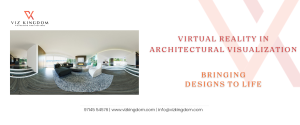
Virtual Reality in Architectural Visualization Bringing Designs to Life
Virtual reality (VR) technology has advanced significantly in the last several years, transforming a number of sectors through immersive and interactive experiences. Architectural visualisation is one field that this technology has tremendously helped. It is now possible for designers and architects to completely realise their ideas, giving stakeholders and clients the opportunity to view virtual spaces before they are constructed with the help of virtual reality in architectural walkthrough.
Architectural visualisation has been profoundly impacted by virtual reality, which has changed how designs are imagined, conveyed, and experienced. VR must be embraced by designers and architects as a useful tool in their toolbox as technology advances, allowing them to push the limits of architectural visualisation. This article explores virtual reality’s influence on architectural visualisation and how it could revolutionise the industry.
Exceptional level of immersion
A level of immersion not possible with standard 2D representations or physical models is provided by virtual reality. Wearing a virtual reality headset immerses users in an environment that appears realistic, giving them a first-hand understanding of space, scale, and materials. Before building starts, this virtual experience helps clients and architects visualise designs more accurately and make well-informed decisions.
Users can have a realistic and immersive experience in architectural areas with VR. Architects can utilise virtual reality (VR) to present their designs and get insightful input from stakeholders and clients. Also, by visiting virtual places in person, clients can make better-informed decisions regarding design selections.
Endless possibilities for selections
It is possible to prepare a virtual tour for a customer with different furniture and materials options which help customers to see the same space with different combinations of colors, textures, tiles, furniture etc and select the best one that suits their taste. This is a very useful feature of interactive virtual tours that not only excite and engage the customer with design, but also gives clarity and offers best options to choose from.
Better and improved communication
In architectural projects, cooperation between architects, clients, engineers, and contractors is crucial. Conventional means of communication, such 2D drawings or blueprints, frequently result in misconceptions or misinterpretations. Conversely, virtual reality technology helps to close these gaps in communication by giving all parties involved a way to see and comprehend the design purpose. This degree of clarity guarantees that everyone is on the same page, improves teamwork, and lowers errors.
Virtual Reality (VR) enables efficient cooperation between project teams, clients, and architects. There will be fewer misunderstandings because all parties involved can see and comprehend the design goal more clearly. Client satisfaction and project outcomes both increase with improved communication.
Improved marketing and sales strategies
Virtual reality (VR) has been applied to architecture visualisation not just in the design and building phases but also in marketing and sales techniques. VR is a useful tool for developers and real estate brokers to present properties that are still in the planning or building stages. Potential customers may more clearly see the finished product and make informed judgements about what to buy thanks to this engaging experience. Marketing campaigns become more compelling and engaging when VR is used.
Developers and real estate brokers can present houses in virtual reality (VR) before they are constructed. Virtual tours of properties are available to prospective purchasers, which helps with decision-making. VR-enhanced marketing techniques can draw in investors and boost sales.




